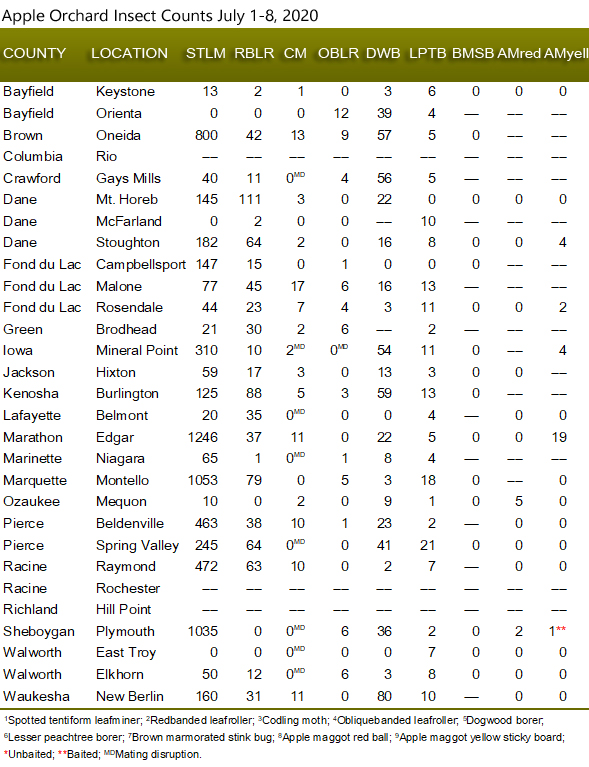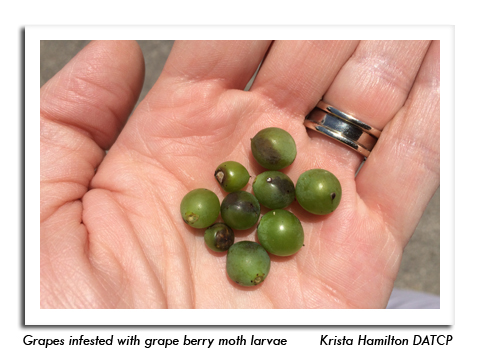
 |
|
|
Fruits
Volume 65 Number 10 Date 07/08/2020 APPLE MAGGOT - Counts on orchard traps have increased since the last report, with flies captured at five cooperating locations, as far north as Marathon County. The highest count for the week ending July 8 was 19 flies on a yellow board. Maintaining traps will be important as emergence continues and oviposition on apples intensifies in late July and early August. CODLING MOTH - Advanced apple orchards are 800-1,000 or more degree days (modified base 50°F) beyond the first biofix, and treatments for second generation larvae are expected to start next week. Apple growers are reminded to rotate insecticides between generations to prevent resistance to chemical materials. Localized larvicide applications are usually an acceptable alternative to orchard-wide treatment for sites with variable larval pressure between cultivars or blocks. SPOTTED TENTIFORM LEAFMINER - The second flight should peak soon at most monitoring sites. Several orchards reported counts above 400 moths per trap per week, with a high of 1,246 moths per trap registered in Marathon County. Heavy egg laying can be expected as long as pheromone traps are attracting high numbers of moths. Apple orchards with populations greater than one mine per leaf or a history of infestation should consider controlling second-generation larvae to reduce buildup of leafminers before the third flight begins in late July or August. JAPANESE BEETLE - Beetle pressure is increasing in Wisconsin apple orchards and vineyards. Damage to fruits, ornamentals and field crops will continue to intensify this month and control may be needed to prevent fruit loss. Most chemical treatments are only effective against Japanese beetle when populations are low and the beetles are first migrating into vineyards and orchards. BROWN MARMORATED STINK BUG - Nymphs are emerging in Dane and La Crosse counties. BMSB clear sticky panel traps should be in place to monitor summer stink bug activity. Cooperators are reminded that the sticky traps now supplied by DATCP must be baited with a combination of BMSB lure and the green stink bug (GSB) lure provided with this season's trapping supplies. GRAPE BERRY MOTH - Female moths will soon begin laying second-generation eggs in southern and western Wisconsin vineyards. Scouting for infested fruits and other signs of GBM, particularly in border rows adjacent to wooded areas in the vineyard, is advised. Treatment of perimeter rows, if warranted, usually provides satisfactory control of this pest. The use of pheromone traps to monitor GBM flights and properly timed controls is also strongly recommended. OBLIQUEBANDED LEAFROLLER - Second-generation larvae ranging from newly-hatched to the intermediate stages were observed in the past week. Effective control of the current brood will minimize injury and reduce the size of the later generation in August and September. Treatment is justifiable when 3% of terminals are infested, based on examination of five growing points per tree in at least 10 widely separated trees. SPOTTED WING DROSOPHILA - Berry growers in southern and western Wisconsin have reported finding initial larval infestations in their blackberries and raspberries in the past two weeks, indicating sampling for larvae in fruit should begin. To sample from a planting, place at least 15 ripe fruit in a plastic bag and lightly squeeze each fruit. Add a strong salt solution (1/4 cup salt to 1 quart water), enough to cover all of the fruit, to the bag. If present, small white SWD larvae will emerge and rise to the top of the liquid after 30 minutes. A more complete guide to the sampling process is available at https://www.canr.msu.edu/ipm/uploads/files/SWD/SWD_2013-Salt_Sugar_Boil_Test-6-20-2013.pdf. Managing SWD requires persistence and the use of as many control techniques as possible. -- Krista Hamilton, DATCP Entomologist 

.jpg)
.jpg)

.jpg)
|
|
|